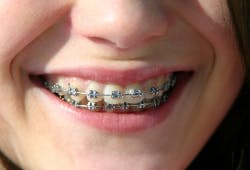Effectiveness of the end-tufted toothbrush to clean around bonded retainer wires
By Audrey Lawrence Rosenberg, RDH, BS
Orthodontists increasingly apply permanent retainer wires bonded to the lingual surfaces of mandibular anterior teeth and to the lingual surfaces of maxillary centrals. This solution makes flossing very difficult, especially for teenagers, even with the aid of such adjuncts as floss threaders, Soft-Pick, Super Floss,and water flossers.
I gave one teenage patient an end-tufted brush because he seemed to have poor compliance with flossing. His compliance with the recommendation was better than I’d hoped for. I gave another patient an end-tufted brush to use as an alternative because a wrist injury made flossing difficult. Again, acceptance and compliance were very positive.
The patients’ ages ranged form early teens to mid 50s. The 25 patients with the worst symptoms went into the experimental group, the other five went into the control group. I designated a group for each patient at the initial exam.
All 25 patients in the experimental group presented with puffy hemorrhagic gingival tissue, which was shiny, red, rolled with blunting papilla. Most of patients thought the bleeding was normal. The five patients assigned to the control group were maintaining a moderate level of gingivitis.
I noticed the most dramatic change at the first recare visit. The 25 experimental group patients returned for recare with favorable acceptance and were delighted with the ease of care with the new brush. Each had minimal depositing at the first recare visit. Less than an eighth of each tooth collected new deposits supragingivally, and no formation of subgingival calculus was detected. None had bleeding upon probing nor blunted papilla. The gingival tissue was healthy and stippled with tight knife-edge margins, and probing depths were 1 or 2. There was no evidence of spongy or rolling margins.
In contrast, the five patients in the control group showed little change. For example, a patient from the control group returned for his second six-month recare visit and was using Soft-Pick as an adjunctive device to help clean his permanent retainer. Although he reported exemplary home care, there was still subgingival calculus, as well as significant depositing around the contacts and where the wire covered the embrasure space. In fact, I was able to see exactly where he applied the pick, based on calculus formation. Throughout the study, I measured results using the indices described in Glickman’s Clinical Periodontology.
Calculus Index:
- 0= No calculus present.
- 1= Supragingival calculus covering not more than one third of the exposed tooth surface.
- 2= Supragingival calculus covering more than one third but not more than two-thirds of the exposed tooth surface, or the presence of individual flecks of subgingival calculus around the cervical part of the tooth, or both.
- 3= Supragingival calculus covering more than two-thirds of the exposed tooth surface, or a continuous heavy band of subgingival calculus around the cervical portion of the tooth, or both.
Gingival Status (Gingivitis Index):
- 0= Absence of signs of inflammation.
- 1= Mild to moderate inflammatory gingival changes, not extending around the tooth.
- 2= Mild to moderately severe gingivitis extending all around the tooth.
- 3= Severe gingivitis characterized by marked redness and swelling, tendency to bleed, and ulceration.
Control and experimental group determinants: Anyone scoring 3 or greater in either or both scales was placed in the experimental group. Five of the 30 patients were already using adjuncts to clean around the wire. I assigned them to the control group.
Each member of the control group was already using either Soft-Pick, the sharp end of a floss stick, Water Pik, or Super Floss. They had inflamed and blunted papilla, bleeding on probing and calculus covering the retainer wires. Because they were already using an adjunctive cleaning situation for the permanently bonded retainer wire, and the gingival index was not greater then 2, I didn’t want to disrupt their good habits.
Each patient in this study was given a lesson on the circular method of brushing.
The experimental group patients were given an end-tufted toothbrush, in addition, and instruction on its use.
Results for experimental group:
1. Initial visit: 25 patients average scores:
- Calculus Index: 3
- Gingival Status: 3
2. First six-month recare visit: 25 patients average scores:
- Calculus Index: 0.5 - 1 .0
- Gingival Status: 0.5
3. Second recare visit: 25 patients average scores:
- Calculus Index: 0.5 - 1 .0
- Gingival Status: 0.5
The calculus and gingival numbers dropped significantly from the initial exam to the first recare visit. This suggests that the end-tufted brush is highly effective.
The results suggest that the end-tufted brush was easy to use and very effective in reducing plaque, inflammation, and bleeding in all ages.
Most of the experimental group patients were between the ages of 13 and 22. Acceptance and compliance was excellent even with the teenagers. All patients said that they found the end-tufted brush easy to use, and they used it regularly. This would explain why the results were so dramatic.
After the first recare visits, I was concerned about continued compliance and gingival health maintenance. However, the gingival and calculus scores did not rebound on the second visit. Also, the overwhelming verbal response was very positive. All said that they liked the feeling and the brush was very easy to use, and they expected to continue using it.
Results for the control group
1. Control group initial visit: 5 patients average scores:
- Calculus Index: 2
- Gingival Status: 2
2. Six-month recare visits: 5 patients average scores:
- Calculus Index: 2
- Gingival Status: 2
3. Second recare visit: 5 patients average scores:
- Calculus Index: 2
- Gingival Status: 2
When the five control group members returned for their recare visits, I noticed little change: moderate calculus around the appliance, gingival margins, and interproximally.
I noticed there was no change in the control group at any of the intervals. The gingival tissue was puffy, light to moderate depositing existed, and there was a mild case of gingivitis.
Conclusion
The end-tufted brush has a sturdy handle and can easily reach difficult areas as well as being very effective in removing plaque, preventing calculus, and massaging gingival tissue.
The results after recall visits of the experimental group were so significant that I recommended it to all of my patients with permanently bonded retainer wires, including the control group.
References
- Spolsky, Epidemiology of Gingival and Periodontal Disease in Glickman, I, Carranza F. Glickman’s Clinical Periodontology. University of Michigan: W B Saunders Co; 7th edition( Februry 1990 324-5) Carrenza, The Epidemimology
- Lawrence A. Circular Method of Brushing. Toothsurvey website. Toothsurvey.webs.compublished1987. Accessed 11/9/2016.


